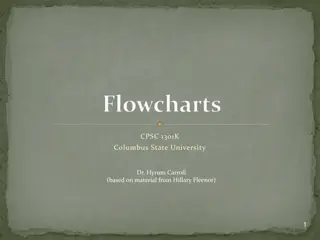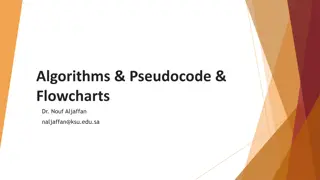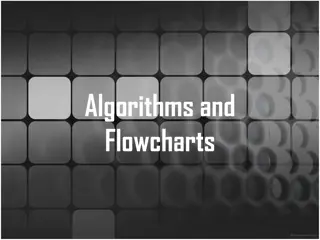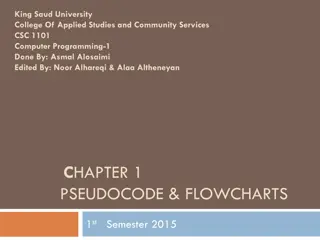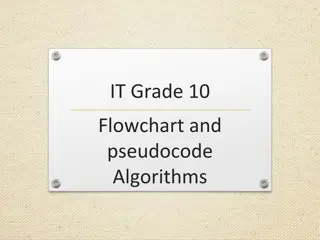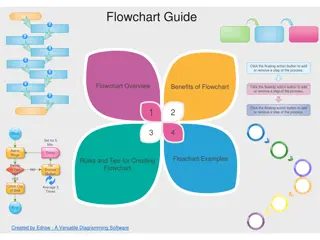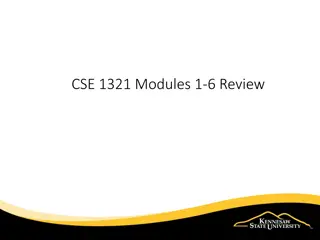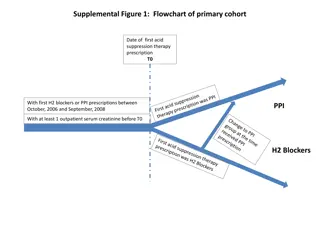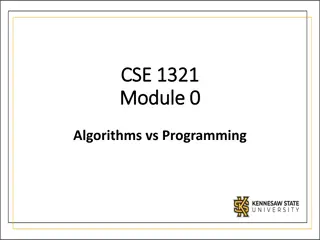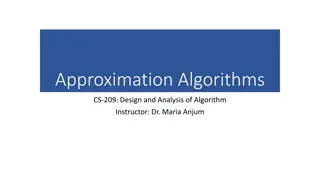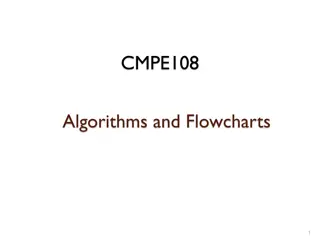Introduction to Algorithms and Flowcharts
A program consists of instructions given to a computer to execute operations and solve specific problems. To solve a problem in computers, steps like analyzing the problem, writing an algorithm, creating flowcharts, converting flowcharts to programs, and testing the solution must be followed. Algorithms are a series of steps to solve a problem, while flowcharts visually represent problem-solving processes. They help in logical thinking, data processing, writing programs, error prevention, programming language conversion, and breaking down complex problems. Different types of flowcharts include simple sequence, branched, single loop, and multi-loop charts.
Download Presentation

Please find below an Image/Link to download the presentation.
The content on the website is provided AS IS for your information and personal use only. It may not be sold, licensed, or shared on other websites without obtaining consent from the author. Download presentation by click this link. If you encounter any issues during the download, it is possible that the publisher has removed the file from their server.
E N D
Presentation Transcript
CHAPTER TWO Algorithms and Flowcharts Introduction A program is a set of instruction gave to the computer to execute successive operations leads to solve specific problem. In general to solve any problem in computer we must follow these steps: 1. Analyze the problem. 2. Write an Algorithm. 3. Draw flowchart. 4. Convert the flowchart to program. 5. Run the program and test the solution.
1-1: Algorithms It is a combination of phrases and events that can be arranged as steps to solve a specific problem. That can be done by understanding this problem whether it mathematic or logic before convert it to flow chart. As example when we borrow some books from the library, the remaining books number (NR) is the subtraction of the borrowed books number (NB) from the original number (NO). To write the algorithm for this simple problem we will follow these steps: Input the number of books in the library (NO). Input the number of borrowed books (NB). Find the remaining books number (NR), NR= NO-NB Print NR
1-2: Flowcharts Flowcharts are graphs that represent the formal view used to solve any problem. Flowcharts help the programmer to write his program. Flowcharts consist of a shapes connected by a straight lines. The following table shows these shapes and their operations.
We can summarize the use of algorithms and flowcharts as follow: 1. To show the mathematical logic used to solve problems. 2. To show how the data processing is done. 3. Helps the programmer to write his program. 4. Divides the big problem to smaller parts. 5. To avoid the errors that occurred during writing the program. 6. It is a middle step between problem difficulty and its conversion to suitable program. 7. Easy to convert it to any programming language.
In general, we can divide flowcharts to a four shapes (charts): 1. Simple sequence charts 2. Branched charts. 3. Single loop charts. 4. Multi-loop charts.
1-2-1: Simple sequence charts The events arrangement of this type is as straight sequence from the beginning of the program to the end (Event-1 to Event-n in figure below). This type of charts does not have any branches or loops.



